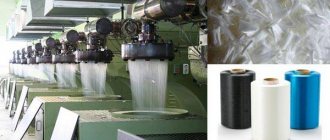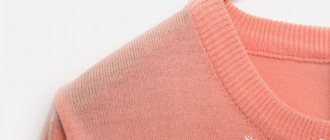A sweatshirt with your design and/or number is a comfortable, soft and practical item. In order for it to last the entire period specified in the material, you need to know and follow several care rules: how to wear it carefully, wash it, iron it and dry it. In fact, this is not such a difficult task: you can and should clean a sweatshirt less often than other knitted items. Here are some tips for caring for this warm item.
How often should T-shirts be washed?
A guide to how often you should wash certain items: T-shirts - after every wear. Socks - after every wear. Underwear - after every wear.
Interesting materials:
What is made from coconut palm? What do compression stockings do? What do diuretics do? What do Muslims do on Friday? What do they do at the cemetery on Parents' Saturday? What do they do during a medical examination with a surgeon? What do they do on Christmastide? What do they do at customs at the airport? What do they do with steroids? What do welders do at work?
How to wash a sweatshirt in the washing machine
Many people wash a sweatshirt in the machine - this does not harm it. You need to do this:
- Turn the jacket inside out. Turning inside out protects the color and condition of the fabric, so the item remains soft and vibrant. The product with a zipper must be fastened and the slider secured with a pin so that the lock does not “unravel” during washing.
- Pour liquid powder into the machine. Many people pour it directly into the washing machine drum, making washing more efficient.
- Carefully fold the sweatshirt and place it in the washing bag. Load into car. You can add other items of the same color that need washing.
- Select washing settings (more on them later). Launch.
- It is advisable to add conditioner 10-15 minutes before the end.
- When the wash is finished, remove the sweatshirt from the cover and immediately unzip it. The metal lock should not be dried closed. There is no need to turn the product inside out.
Sweatshirts with built-in headphones are also machine washable. Radio-enabled products are sewn in such a way that contact of wires with water does not damage the headphones. But for sweaters with headphones, it is better to turn off the spin function and reduce the speed.
How to restore the shape of a jacket if it has shrunk
The sweatshirt shrinks if the water temperature in the wash was above 40 °C and the spin cycle was more than 600 rpm.
The original size of the jacket is returned as follows:
- Fill a bowl with very cold water. First keep the tap water in the refrigerator or add ice cubes to it.
- Place the shrunken hoodie in the liquid, immerse completely and leave for 15-20 minutes.
- Remove and wash as usual (by hand or on delicate cycle). Disable spin.
- Wring out the item with your hands, stretching it lengthwise (from top to bottom and along the sleeves). Dry vertically on a line.
Basic Rules
If you wash sweatshirts and sweatshirts frequently, they may lose their shape, stretch out, or pill. Therefore, such things are not simply washed, only if there is serious contamination. The more often clothes are treated with water, the faster they will age. Even if you use the quick wash mode.
If the contamination is local, you can use a sponge soaked in a detergent solution. This way you can keep the print on your clothes longer and prevent pilling. With such spot treatment, the item is not wrung out and is not subjected to excessive mechanical stress. If you are unable to get rid of the stain using a sponge with detergent, it is better to resort to dry cleaning services. Experimenting with stain removers can completely ruin the item.
The better to wash
The following products are used to machine wash sweatshirts:
- liquid powder (Lenor, Perwoll, Sama, Persil, Dalli, etc.) - 1 cap (or 1 tablespoon of loose powder, but liquid is better);
- universal conditioner - 1 cap.
There is no need to select a powder for a specific material - a universal one will do. But for a brightly colored sweatshirt, it is better to buy a product for colored things.
Avoid chlorine-containing products and other bleaches. They also do not use special fabric conditioner - the composition of the product sometimes harms knitted items.
What happens if you wash things at 60 degrees?
60 degrees is the temperature at which things are already disinfected. It can be used for bed linen, towels and things that really need it. For example, you can wash a child’s clothes after an illness.
Interesting materials:
Is it possible to get MTPL insurance for 6 months? Is it possible to provide hairdressing services at home? Is it possible to describe a circle around a quadrilateral that has only one right angle? Is it possible to describe a circle around a rectangular trapezoid? Is it possible to describe a circle around a square? Is it possible to pay for halva at McDonald's? Is it possible to pay taxes through my personal account? Is it possible to determine the location of a subscriber without his knowledge? Is it possible to define the process of perception as a synthesis of sensations? Is it possible to determine the case of short adjectives?
What kind of fabric is it and what is it made from?
Footer refers to an assortment of knitwear, in the production of which a specific weaving technique is used - lining.
The back of the canvas has soft fibers. The front surface has a smooth texture with a very fine scar.
Types of footer:
- Single thread. Cotton acts as a raw material. This type of knitwear is distinguished by its delicacy and fine structure.
- With lycra. The fabric acquires elasticity and resistance to shape changes. Its strength increases.
- Interlock. It is distinguished by the same smooth plane on both sides.
- Double thread footer. It contains synthetics, most often polyester, which provides the fabric with elasticity.
- Looped (three threads). Thanks to the combination of wool fibers and lycra, a very dense knitwear is obtained.
- With fleece. It is distinguished by voluminous pile in the form of loops, located on the reverse side of the fabric.
What does the footer look like?
Advantages of lining fabric:
- softness;
- high moisture absorption;
- long-term operation with preservation of color decor;
- good thermoregulatory qualities, providing protection from cold and heat retention;
- the ability to eliminate irritation even on sensitive skin.
This knitwear does not stretch, which helps maintain the size of items and their shape. There are no puffs or pellets on the surfaces.
Interlock is perfect for making comfortable home products - pajamas, dressing gowns. Sportswear is made from double thread.
Features of washing a sweatshirt with a print
Products with thermally printed patterns require more careful handling - the pattern runs the risk of cracking and starting to “slip.”
| Regular wash | Wash with print |
| Washable by hand and machine | Hand wash only |
| Spin allowed | Spin is not recommended |
| It is better to turn inside out before washing, but this condition is not necessary. | Always turn it inside out |
| Water temperature can fluctuate 30-40 °C | It is better not to exceed the temperature of 30 °C |
How to Monitor a Rashguard
Rashguard is a more specialized and sporty type of clothing. It has its own rules of care. Unfortunately, in stores, in most cases they don’t talk about this. But, taking them into account, it is possible to preserve the original appearance for as long as possible.
The main problem with the product is the unpleasant odor released after the first wear.
To avoid this, immediately after arriving home, the product should be rinsed. In this case, the water should be cold or slightly warm, but in no case hot. Then the sweat will not have time to be absorbed. If the smell does not disappear, then add washing powder to the water.
After rinsing, the rashguard is lightly wrung out and hung on the dryer. Naturally, using a battery to speed up the process is strictly prohibited!
Washing a rash guard
Depending on the number of workouts, choose the time for washing. On average, this is once every 7-10 days. If you train very often, it is better to have 2 products and while one is being washed, the other can be worn.
The manufacturer will tell you how to wash the rash guard. To do this, you need to study the tag and follow the advice given there. The washing machine, unlike the previous product, cannot be used. Typically, the water temperature during hand washing should not exceed 30 degrees, and special soft powders are selected.
It is better to turn the product inside out. Already at forty degrees and above, the delicate structure of the tissue is destroyed. Then the thing loses its appearance and its original properties or, as they say, “shrinks.”
Keep in mind that in order for the rashguard to remain as good as new, forget about hot water, a battery and a dryer, or you will have to part with your favorite item.
In what mode are knitted items washed?
Modern washing machines have a manual or delicate wash mode. In such modes, clothes made of wool and silk are washed.
Most delicate items require careful handling, but there are exceptions. If the product is woven from dense threads with the inclusion of synthetics, then a special mode is not required.
If you decide not to hand wash, then you should know how to properly wash a sweater in a washing machine. The knitted product is placed in a special laundry bag designed specifically for such clothes. The protective bag prevents the appearance of creases, stretching or tightening on the product.
After the manual or delicate wash mode, it is not recommended to select the additional spin function. In this mode, the item is more likely to lose its shape and size. The exception is thick threads with the inclusion of synthetic fiber, which are often found in blankets. It is permissible to spin them in a washing machine, but with a minimum number of revolutions per minute.
Requirements for washing woolen items
Wool is a more capricious material. Not every item made from it can be washed in an automatic machine. It all depends on the composition of the fabric. If less than 50% wool was used in the manufacture of a sweater, and the rest is pure synthetics, a washing machine will most likely not spoil such a product. However, you should play it safe and turn off the drying and spinning modes.
In other cases, woolen items should only be washed by hand. How to wash a wool sweater without unpleasant consequences?
- The sweater must be turned inside out.
- After this, draw warm water no higher than 30 degrees and dissolve washing powder in it. For very thin, delicate items made of wool, baby shampoo or a special product designed for washing such items is suitable.
- Woolen clothes should be soaked for 5-10 minutes, lightly wrinkled with your hands, and then drained.
- After this, the sweater is rinsed and the water is allowed to drain, pressing lightly. You can't twist it too much. This way you can stretch the product very much.
- Dry woolen clothes on a flat surface in a horizontal position on a thick towel or clean sheet.
- You need to iron such things very carefully. The iron should not be pulled across the surface, otherwise the product will lose its shape. It needs to be lightly leaned against the fabric and lifted.
Answering the question of housewives: how to wash a woolen sweater, experts advise, in addition to following these rules, to sweep away buttonholes so that they do not become larger during the washing process.
Tips for housewives: how to easily wash wool?
Useful tips for washing woolen items. Part 1
Big wash - Everything will be fine - Issue 345 - 02.24.14 - Everything will be fine - Everything will be fine
How to wear it correctly?
When wearing something like a sweatshirt, there are some rules to follow. You can’t often wear it under a jacket, because pellets quickly form on the surface, worsening its appearance. It is better if nothing is put on the sweatshirt, avoid unnecessary contact. The main time for wearing is the off-season, when it is already quite warm outside.
Using these simple tips, you can maintain the appearance of your clothes. It will serve you for a long time. Be sure to follow the washing guidelines above and follow the label directions.
Interesting:
- How to wash things without pilling?
- Washing a sweater
- Washing a pleated skirt
- Washing stockings with silicone elastic
- How to wash a terry robe
- What to do if your T-shirt shrinks after washing?
1 reader comment
- 11/16/2020 at 11:03
Anonymous:
I want to say that everything is quite educational, especially for those who do not know how to do laundry.
Answer
Adviсe
When washing sweaters, it is important to follow a few tips:
Rinsing in cool water with the addition of fabric softener will help reduce the ability of synthetic sweaters to accumulate static electricity.- Rinsing in water with added glycerin will help restore softness and fluffiness to the angora product.
- It is prohibited to use dry abrasive powders to wash jackets. Ignoring this recommendation may result in very small tears in the knitted fabric.
- It is strictly forbidden to dry a jacket on a radiator, near an open fire.
If you are interested in how to wash and clean outerwear, take a look here.
Drying
In order to dry woolen items without harming them, you should use simple precautions:
- Knitted material does not tolerate temperature fluctuations. The drying room must have a stable temperature.
- Do not allow the fabric to overheat. How many degrees it was when washing, so much should be when drying (less can be done, but not more).
- No clothespins, they will stretch the fabric.
- Using a thin clothesline will cause creases.
- The correct way to dry such items is to place them on a horizontal surface. To speed up the process, you can put a towel under them.
Handwash
SMA seems to have figured out how to do laundry; everything is quite simple, considering that the equipment does almost everything for you. With hand knitting, everything is not much more complicated, and most importantly, it is most preferable for woolen knitted products. Because there is less chance that the item may shrink or, conversely, stretch.
Of course, many people believe that the most reliable option is to use dry cleaning services, but this is not entirely true. Because no one will provide you with a 100% guarantee of a successful outcome. And here you can independently control the entire process and, on top of that, you will save a lot of money.
So, the action algorithm is as follows: fill a small container with warm water, dilute laundry detergent in it and place a knitted sweater there. Then leave it to lie there for about 10 minutes, then rub your hands over the areas of greatest contamination - sleeves, elbows, collars; if necessary, they can be additionally treated with soap.
The main thing is not to rub or pull too hard, as the item may become deformed; squeezing is also not recommended; gather everything into a ball and squeeze. You need to rinse in a liquid at the same temperature as you washed; you can use a softener to soften it. And if you don’t have it, prepare a vinegar solution for 5 liters of liquid; you need to take 2 tablespoons of vinegar.
If you don't like the smell, you can use regular hair conditioner. Then hang it carefully, so excess moisture drips off, then lay it on a towel and roll it into a roll, this will allow the remaining excess moisture to be absorbed into the terry. It is best to dry by laying the item on a white sheet, this will prevent it from being painted in other colors. To prevent it from acquiring a musty smell, turn it over periodically.
SMS selection
When choosing a detergent, it is better to give preference to special formulations intended for woolen products, for example Laska, Pushok, Dreft, Frosck, Perwoll. Since ordinary powders are very roughly cleaned, the thread gradually loses its fluffiness, and, as a result, the product stops heating.
While special gels contain components that can extend the wear period significantly, their consumption is quite economical. But if you can’t buy it, you can replace it with regular hair shampoo. Also, special washing balls have recently appeared on the market; they are, of course, very effective, but they are also quite expensive.











